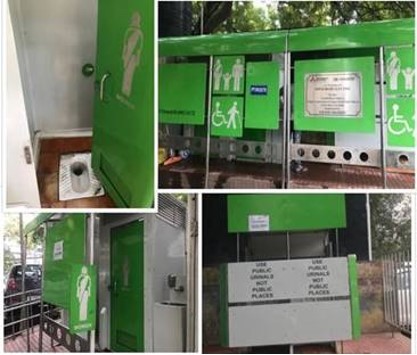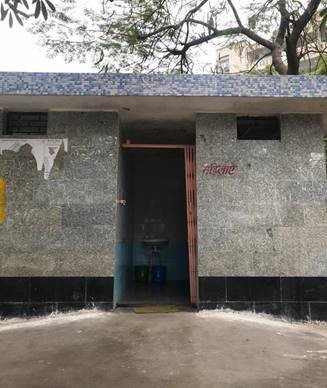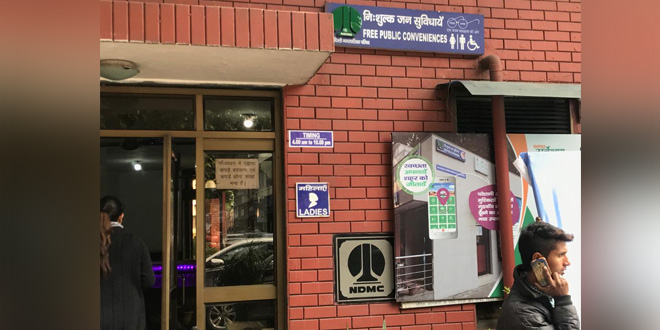New Delhi: 28-year-old, Rohit (name changed) who has lived in South Delhi for about 10 years, commutes to work daily via cab from New Friends Colony to Vasant Kunj, a distance of 17 kilometres one way. On this long travel route, if ever he feels the need to use a public convenience then there are numerous options. That’s the good news. However, the bad news is he prefers to relieve himself in the open, ‘given the sorry state of the toilets’, as he says.
For people like Rohit, are habituated to using toilets and don’t need awareness campaigns to educate them about health and hygiene implications of not using a toilet. And yet the reality on the streets of a city like Delhi makes it difficult to adhere to healthy sanitation norms. But how much of this behaviour is due to a genuine lack of well-maintained toilets or is it just a perception that if it is a public toilet then it has got to stink!
NDTV’s Banega Swasth India team decided to conduct an on-ground reality check on the condition of a bunch of public toilets in Delhi, here are the findings.
Nehru Place Market, South Delhi
Nehru place market is a hub for shopkeepers, street vendors, hawkers selling electronic products. Being one of the largest centres for computer hardware and peripherals in Delhi, it sees huge footfalls in terms customers and general passersby from the neighbouring office complexes. In addition there are parking facilities as all need to well as security guards, both male and females, who access the toilets situated here, free of cost. Considering the high usage of these facilities, the NDTV team visited these toilets twice.
The first visit our team made was in the evening at around 6, which is a peak time in terms of crowds in the complex. During this visit the team found that there was no electricity or running water available and the toilets were very dirty and over-used. When the caretaker was asked about the lack of water, he said,
This is an everyday story. By the end of the day, the water tank gets empty and we have no water to even clean the toilets.
The power cut on the other hand happens often, he informed.
When the toilets were visited again the next morning, water and electricity were available but cleanliness and stench remained an issue and a different caretaker on shift this time, blamed the condition of the toilets on overuse.

The urinals and toilets meant for women, part of the public toilet complex in Nehru Place Market, in South Delhi was found to have no access to running water and had unclean seats
Qutub Minar Metro Station, South Delhi
The Qutub Minar metro stations is just 2 minutes’ walk away from the world famous UNESCO heritage site built in 1193. One of the prime tourist spots of the capital, it is estimated the 3.9 million people visit it every year. This set of toilets for both men and women, located right outside the Qutub Minar Metro Station on the main road, were locked when we visited it around 4 pm, a few months ago. When the team approached a street vendor selling lemonade right across the toilet complex, to enquire if the toilets are functional and if there is a caretaker around. The vendor informed us that the toilets have been locked for months.
We did not find a toilet in the walking distance from this particular unit, and hence questioned the street vendor on where does he relieve himself while working.
I urinate on the street, he responded immediately. This toilet has never been open since I’ve been working here, I can’t leave my cart alone and go find another toilet. I can urinate anywhere in the open here and I do, he added.
However, when the NDTV team visited this particular toilet complex again during February, the complex was functional with running tap water. There was no caretaker present to give details about the complex.

Toilets just outside the Qutub Minar Metro Station were locked, however, on a second visit, couple of months later the toilets were functional
Khan Market – Central Delhi
Named after the freedom fighter, Khan Abdul Jabbar Khan, Khan Market was established in 1951. The U-shaped, double-storey market complex originally had 154 shops and 74 flats on the first floor for shopkeepers. The market today is World’s 20th most expensive retail high street according to a study by the global real estate firm, Cushman & Wakefield.
NDTV visited the toilet complex constructed in this market, which is free to use. The toilets were clean, hygienic and equipped with all the necessary facilities like running water, soap and dustbins.
Sarai Kale Khan Inter-State Bus Terminus, South Delhi
Sarai Kale Khan inter-state bus terminus (ISBT) is one of the busiest bus stands of Delhi. It is also adjacent to the Hazrat Nizamuddin Railway Station and is also a Delhi Transport Corporation bus depot among many other bus routes. Considering the heavy footfall at the bus stand at all times of the day, usage and demand of public toilets in the area is high. Our team spotted one public toilet complex with one seat for male and female each, although it was quite evidently out of service, with no water, electricity or any pretence of cleanliness. Additionally, cases of open urination as well as defecation were evident here.
Moolchand Metro Station
Moolchand Metro Station is one of the busiest metro stations on the violet line in South Delhi. The station, being nearby to several schools like Kendriya Vidyalaya and Frank Anthony, colleges like LSR and also several offices, is used by people of all demographic.
The toilets visited by our team an the Moolchand Metro station were chargeable at Rs. 5. Since the toilet had a user free, there is a caretaker present at all times to collect the money and the toilets were clean and hygienic.
New Ashok Nagar, East Delhi
The New Ashok Nagar is a residential area in East Delhi with a busy metro station. The toilet near New Ashok Nagar metro station can be used free of cost. The toilet had no electricity or running water during the visit by our team in the afternoon. No caretaker was available at the time of visit to answer any queries.

The toilet near New Ashok Nagar Metro Station had no electricity or running water during the visit by our team in the afternoon
Preet Vihar Community Centre, East Delhi
Preet Vihar is a posh residential colony of East Delhi, situated on Vikas Marg. The community centre in the area is known to be busy due to several shops, restaurants and offices situated in it. The community centre also draws crowd from the Preet Vihar metro station. The urinals in the public conveniences in Preet Vihar community centre were open for all who are either occupants of the complex, visiting it or people just passing by. However, we noticed that neither the toilets had access to water nor were these in usable condition, especially the female toilet seats. Dysfunctional flushes meant there was a strong stench in and around the toilets making it very difficult for anyone just passing by let alone access these facilities.

The urinals in the public conveniences in Preet Vihar community centre were open for all who are either occupants of the complex, visiting it or people just passing by
Why Are These Toilets Not Maintained?
According to World Health Organisation, shared toilets like public and community toilets, if not maintained well could cause serious health issues and infections.
Maintenance of toilets is a problem for both citizens as well as authorities, as over usage and lack of awareness about toilet usage among general public all also adds to the poor condition of the toilets.
A 19-year-old female domestic worker from Amar Colony area in capital told the NDTV team that each time she visits a public toilet, the smell and the unhygienic conditions repulse her so much that she prefers not using these. She also says that many toilets often miss the basic amenities.
Some of the toilets listed above too lacked basic facilities like running water, electricity and in some cases even flush.
On the other hand, a fruit vendor from the Lajpat Nagar area told us that he never even checks if there’s a toilet around. When asked why he said,
I just don’t, it a matter of habit. It never strikes me.
Paid Toilets Vs Free Toilets
On the visit, we also observed that the condition of a particular toilet depended heavily upon if it’s a pay-to-use toilet or free-to-use. The paid toilets always had a caretaker around to ensure cleanliness of the toilets and collect the money. We could also complain about any issue to the caretaker and they tried to help.
However, in the free toilets there was rarely any caretaker around to seek help from and the condition of the toilet was comparatively not fit for use.
Behavioural Issue Vs Condition Of Toilets
“Behavioural issue is probably the biggest challenge of all,” an East Delhi Municipal Corporation (EDMC) official told NDTV when questioned about the difficulties they face when it comes to maintaining public toilets. He further said that EDMC does not charge any user fee from the residents wanting to use the public toilets, with the aim to make the toilets as accessible as possible.
However, we have noticed that more than often, our caretakers will find that a user will urinate and defecate inside the public toilet, but on the floor and not on the seat. This ultimately makes it difficult for us to maintain them, resulting in bad condition of the toilets, he explained.
Another behavioural issue amongst the public, he said, is that even if there are toilets available in the vicinity, they choose to relieve themselves in the open as a habit. He said,
Maybe the habit is lingering from when they did not have any access to toilets and we are trying our best to change this behaviour. A lot has already been changed, but yes we admit that have a long way to go, the official added.
Building Toilets Not Enough: Expert
Jyoti Sharma, President of the not-profit organisation, FORCE, worked on ground to ensure toilet accessibility in Delhi and has been in touch with the authorities, care takers as well as the residents. Speaking to NDTV, she praised authorities’ ‘commendable efforts’ in overall improvement of the access to toilets.
Over the last two years, thousands of new toilet seats have been constructed or refurbished units have been installed throughout Delhi’s public and community toilets. The construction is of good quality and they have made small changes to the design, to make these toilets more user friendly. Special care has been taken to ensure a source of water supply for each toilet. Also, outsourced vendors and caretakers are monitored regularly and every complaint is addressed. If you pick up any random 5 toilets, you will find usage has gone up since the last two years. There has been a definite shift towards use of toilets and lowered littering. You will find caretakers present in most. They are monitored regularly and surprise visits are made, she said adding that problems in the area persists despite these efforts.
Ms. Sharma further tells NDTV that despite the slew of measures taken by the authorities in increasing toilet accessibility, in her opinion, the problems persist because of four major reasons.
- High pressure of the population on these facilities end up making it difficult to manage them;
- Lack of space where facilities are required.
- No scheme in place to enable people to make toilets in their own homes because of which only Community toilet complexes can be made and for the upwardly mobile population of these areas, this is a limitation.
- She also believes that the lack of co-ordination between authorities and DUSIB acts as a major barrier in the large-scale development of the citizens. This is because while the Municipal Caorporations in Delhi are under the Bhartiya Janta Party, DUSIB comes under Aam Admi Party and this results in political clashes, where public interest is often compromised.
NDTV also consulted a freelance WASH (Water, Sanitation and Hygiene) consultant regarding the issue, he firmly asserted off the record, that the practice of constructing toilets is not going to be the sole reason for the end of open defecation in India; it ultimately comes down to if the toilets are usable.
Sustainable Development Goals don’t only talk about having access to toilets. It is also about safely managed access as well as equity. Even if the government goes on a toilet building spree, and provides a toilet in every 500 meters, it does not ensure that the city is ODF. It is not always about behaviourial issue. At the end of the day, these are shared toilets and need to be managed accordingly. WHO states that shared toilets, if not maintained, have high chances of spreading infections and other diseases. So what we need is improved and safely managed toilets, he explained to NDTV on the condition of anonymity.
As the expert pointed out, building toilets is not going to aid any city in sustaining ODF. Need of the hour, in addition to spreading awareness about the hazards of open defecation among the urban poor, is maintaining the facilities provided in the existing public toilets so that they are easily accessible for people belonging to any economic strata. Rigorous monitoring of the conditions of the toilets and prioritising public health and cleanliness of the city should be the main agenda for the authorities.
Status of Sanitation In Delhi
-
Thousands Of Toilets Built Since 2014 Yet Access To Toilets Remains An Issue In The National Capital
-
“Building Toilets Is Not Enough To Eradicate Open Defecation,” Experts
-
Despite Community Toilets Built, Access Remains An Issue For Slum Dwellers In Delhi
-
We Feel Safe Using Pink Toilets,’ Vote The Women Of New Delhi






 Thousands Of Toilets Built Since 2014 Yet Access To Toilets Remains An Issue In The National Capital
Thousands Of Toilets Built Since 2014 Yet Access To Toilets Remains An Issue In The National Capital “Building Toilets Is Not Enough To Eradicate Open Defecation,” Experts
“Building Toilets Is Not Enough To Eradicate Open Defecation,” Experts Despite Community Toilets Built, Access Remains An Issue For Slum Dwellers In Delhi
Despite Community Toilets Built, Access Remains An Issue For Slum Dwellers In Delhi We Feel Safe Using Pink Toilets,’ Vote The Women Of New Delhi
We Feel Safe Using Pink Toilets,’ Vote The Women Of New Delhi
























